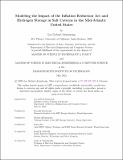| dc.contributor.advisor | Macdonald, Ruaridh | |
| dc.contributor.advisor | Mallapragada, Dharik | |
| dc.contributor.advisor | Ilić, Marija | |
| dc.contributor.author | Armstrong, Les Gabriel | |
| dc.date.accessioned | 2024-09-24T18:22:24Z | |
| dc.date.available | 2024-09-24T18:22:24Z | |
| dc.date.issued | 2024-05 | |
| dc.date.submitted | 2024-07-25T14:17:33.735Z | |
| dc.identifier.uri | https://hdl.handle.net/1721.1/156949 | |
| dc.description.abstract | Hydrogen is widely understood to be critical for decarbonizing hard-to-abate sectors like heavy industry, long-distance transportation, as well as balancing a variable renewable energy dominated power grid.
In this thesis, we first propose a methodology for evaluating the potential for hydrogen storage in geological salt resources. Our results show that the Michigan and Appalachian Salina basins are promising locations for hydrogen storage in salt caverns. After applying a coarse techno-economic filter, the storage potential of the remaining high value caverns is 9.7 × 108 metric tons of H2 or 32.4 PWh in Michigan and 1.6 × 107 metric tons of H2 or 0.54 PWh in the Appalachian region.
We then perform a techno-economic analysis on these salt cavern resources which we utilize as hydrogen storage options in Macro, an open source energy system optimization model that couples the power, hydrogen, and carbon sectors. We then analyze the impact of the Inflation Reduction Act and the presence of salt caverns on the United States Mid- Atlantic region in the year 2035. We find that salt caverns do not have a significant impact on the overall coupled energy system dynamics unless we force a 100% decarbonization constraint. In addition, we also uncovered a perverse behavior induced by the IRA’s hydrogen production tax credit within the model. Further work is required to understand whether this behavior is likely in practice or can be attributed to difficulties modeling real world interactions and internal frictions between actors in the energy sector. | |
| dc.publisher | Massachusetts Institute of Technology | |
| dc.rights | Attribution-NonCommercial-NoDerivatives 4.0 International (CC BY-NC-ND 4.0) | |
| dc.rights | Copyright retained by author(s) | |
| dc.rights.uri | https://creativecommons.org/licenses/by-nc-nd/4.0/ | |
| dc.title | Modeling the Impact of the Inflation Reduction Act and Hydrogen Storage in Salt Caverns in the Mid-Atlantic United States | |
| dc.type | Thesis | |
| dc.description.degree | S.M. | |
| dc.description.degree | S.M. | |
| dc.contributor.department | Massachusetts Institute of Technology. Department of Electrical Engineering and Computer Science | |
| dc.contributor.department | Massachusetts Institute of Technology. Institute for Data, Systems, and Society | |
| dc.contributor.department | Technology and Policy Program | |
| dc.identifier.orcid | 0000-0001-6993-3907 | |
| mit.thesis.degree | Master | |
| thesis.degree.name | Master of Science in Technology and Policy | |
| thesis.degree.name | Master of Science in Electrical Engineering and Computer Science | |
